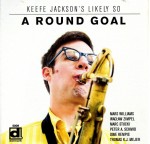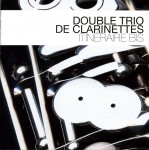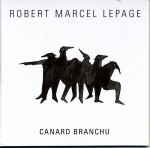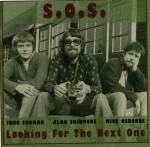Reed sections have been part of jazz’s performing vernacular since its earliest days. But only with the freedom that arose with modern improvised music in the 1960s were the woodwinds able to stand on their own. In the right hands, with the right ideas, a group consisting only of saxophones and/or clarinets can produce satisfying sounds that don’t need the intervention of a rhythm section or even brass for additional colours. All of the fine discs here demonstrate that.
 Chicago tenor saxophonist and bass clarinetist Keefe Jackson extends this concept on A Round Goal (Delmark DE 5009 delmark.com), with his Likely So ensemble consisting of seven reed players. Including two of his Windy City associates – Dave Rempis and Mars Williams – three Swiss stylists – Thomas K.J. Mejer, Peter A. Schmid and Marc Stucki – plus Polish clarinetist Waclaw Zimpel – the septet members play two or three horns each, providing all the necessary contrast and colours for Jackson’s 11-part suite. After leading the others in unison ostinato lines on Round Goal for instance, alto saxophonist Williams sparks the improvisation with jagged, bracing squeaks that inflate to dog-whistle-like glossolalia, without ignoring swing. Similarly while tenor saxophonist Stucki brings prototypical free jazz cries to Was Ist Kultur, the others’ shifting modes ensure the compositional thread isn’t lost. In contrast, tracks like Neither Spin nor Weave and the descriptively titled Pastorale confirm that experimentation doesn’t have to be abrasive. The former, including contributions from five clarinetists, uses mellow architecture to construct a round of calming timbres. Pastorale, meanwhile, is a showcase for Zimpel. His bass clarinet adds a formal sheen to the proceedings, with tongue fluttering gradually giving way to unforced motions. Later, Mejer’s contrabass saxophone is freed from its role providing pedal point textures with the other low-pitched reeds featured on My Time is My Own. Buzzing out notes that could come from a cello played sul ponticello, his smears and snorts are eventually knit into a tapestry of harmonized timbre with the other horns. By the CD’s end it’s obvious that harsh textures can arise from any reed register to build excitement, as can soothing harmonies. Overall, the key point is that individual showiness never takes the place of balanced interaction.
Chicago tenor saxophonist and bass clarinetist Keefe Jackson extends this concept on A Round Goal (Delmark DE 5009 delmark.com), with his Likely So ensemble consisting of seven reed players. Including two of his Windy City associates – Dave Rempis and Mars Williams – three Swiss stylists – Thomas K.J. Mejer, Peter A. Schmid and Marc Stucki – plus Polish clarinetist Waclaw Zimpel – the septet members play two or three horns each, providing all the necessary contrast and colours for Jackson’s 11-part suite. After leading the others in unison ostinato lines on Round Goal for instance, alto saxophonist Williams sparks the improvisation with jagged, bracing squeaks that inflate to dog-whistle-like glossolalia, without ignoring swing. Similarly while tenor saxophonist Stucki brings prototypical free jazz cries to Was Ist Kultur, the others’ shifting modes ensure the compositional thread isn’t lost. In contrast, tracks like Neither Spin nor Weave and the descriptively titled Pastorale confirm that experimentation doesn’t have to be abrasive. The former, including contributions from five clarinetists, uses mellow architecture to construct a round of calming timbres. Pastorale, meanwhile, is a showcase for Zimpel. His bass clarinet adds a formal sheen to the proceedings, with tongue fluttering gradually giving way to unforced motions. Later, Mejer’s contrabass saxophone is freed from its role providing pedal point textures with the other low-pitched reeds featured on My Time is My Own. Buzzing out notes that could come from a cello played sul ponticello, his smears and snorts are eventually knit into a tapestry of harmonized timbre with the other horns. By the CD’s end it’s obvious that harsh textures can arise from any reed register to build excitement, as can soothing harmonies. Overall, the key point is that individual showiness never takes the place of balanced interaction.
 More restrained in execution, but with similar inspirations so that the program never flags, is Itinéraire Bis (Between the Lines BTLCHR 71231 doublemoon.de). Blending two clarinet trios into the Double Trio de Clarinettes, the players use standard, alto, E-flat, bass and contrabass clarinets to highlight the woodwind’s unique properties. Although the Berlin-based Clarinet Trio of Jürgen Kupke, Gebhard Ullmann and Michael Thiecke may be more oriented towards jazz and improvised music and the Paris-based Trio de Clarinettes, which includes Armand Angster, Sylvain Kassap and Jean-Marc Foltz, has more of a new music bent, no fissure exists here. Parameters are established as early as track one, Almost Twenty-Eight, with the reedists spending as much time vocalizing exuberant harmonies as playing. But while such ebullience is present throughout the disc, so is the sophistication that melds atmospheric textures, expressing individual instruments’ rugged or shrill qualities as the pieces advance. Ullmann’s Desert… Bleue… East for instance is a centred performance that includes an unfolding hint of menace, even as vibrating low tones and seagull-like cries are harmonized into a smooth flow. Meantime Kassap takes a more cerebral and musicological approach. His compositions, Bizarre, FAK! and Charles Town, But Yesterday… which follow one another, set up a distinctive continuum. Initially an essay in low pitches, he sabotages the first track’s relaxation with chattering, slightly bizarre interjections ending with a kazoo-like cry; the next sequence deconstructs the line into shaking timbres only to have it snap back into shape following comfortable harmonies from the other players, standard clarinet in the lead; and concludes with a thorough re-examination of the theme. Rhino-like pedal points from the lower-pitched reeds balance the flighty aviary cries from the other woodwinds, with the result beautifully balanced polyphony that succinctly express the theme then stops instantly.
More restrained in execution, but with similar inspirations so that the program never flags, is Itinéraire Bis (Between the Lines BTLCHR 71231 doublemoon.de). Blending two clarinet trios into the Double Trio de Clarinettes, the players use standard, alto, E-flat, bass and contrabass clarinets to highlight the woodwind’s unique properties. Although the Berlin-based Clarinet Trio of Jürgen Kupke, Gebhard Ullmann and Michael Thiecke may be more oriented towards jazz and improvised music and the Paris-based Trio de Clarinettes, which includes Armand Angster, Sylvain Kassap and Jean-Marc Foltz, has more of a new music bent, no fissure exists here. Parameters are established as early as track one, Almost Twenty-Eight, with the reedists spending as much time vocalizing exuberant harmonies as playing. But while such ebullience is present throughout the disc, so is the sophistication that melds atmospheric textures, expressing individual instruments’ rugged or shrill qualities as the pieces advance. Ullmann’s Desert… Bleue… East for instance is a centred performance that includes an unfolding hint of menace, even as vibrating low tones and seagull-like cries are harmonized into a smooth flow. Meantime Kassap takes a more cerebral and musicological approach. His compositions, Bizarre, FAK! and Charles Town, But Yesterday… which follow one another, set up a distinctive continuum. Initially an essay in low pitches, he sabotages the first track’s relaxation with chattering, slightly bizarre interjections ending with a kazoo-like cry; the next sequence deconstructs the line into shaking timbres only to have it snap back into shape following comfortable harmonies from the other players, standard clarinet in the lead; and concludes with a thorough re-examination of the theme. Rhino-like pedal points from the lower-pitched reeds balance the flighty aviary cries from the other woodwinds, with the result beautifully balanced polyphony that succinctly express the theme then stops instantly.
 The difference may result from geography or personality, but in sharp contrast to the concentration on solemn experimentation which characterize the Double Trio and Keefe Jackson CDs, Montreal clarinetist Robert Marcel Lepage's Canard Branchu (Ambiances Magnétiques AM 216 CD actuelcd.com) in the main promotes unselfconscious merriment. With his reputation for creating soundtracks, Lepage sets his compositions here in a fanciful swamp populated by the insects, birds and amphibians. Moreover while many tracks on the other CDs appear to be evolving improvisations, Lepage’s are self-contained songs. Nonetheless while the sounds may be decorous and controlled, they’re not formal and mix good fun alongside technically clever improvisations. The band make-up is different as well. The core is Jean-Sébastien Leblanc and Pierre Emmanuel Poizat on clarinets, Guillaume Bourque, bass clarinet, André Moisan on basset-horn plus bassist Fraser Hollins and drummer Pierre Tanguay, with Nicolas Borycki adding electric organ on three tracks. Bass clarinetist Lori Freedman joins the band on one track and plays another unaccompanied; while the composer plays solo and duets with Moisan on two different cuts. With steady rhythm section work, the others are freed for supple, contrapuntal work, resembling the score for a kids’ show on one hand and Duke Ellington’s arrangements for clarinet trio on the other. Characteristic is Le Pelleteur de nuages, whose church-like harmonies courtesy of Borycki underlie a theme that touches on Can’t Help Falling in Love plus Creole Love Call. Bourque shines on Maringouins en escadron as tremolo horn parts sound as if they come from an accordion; whereas Fondation: qui sommes-nous? is a pseudo-tango that contrasts the basset-horn’s serene chalumeau with slick drum patterns. Chalumeau is also in use on Mi-figue, mi-bémol, Lepage’s solo feature, that improvises succinctly on the melody line, whereas on her own feature, Freedman’s variants on Le Grand Héron et la demoiselle use hectoring cries, irregular vibrations, split tones and spetrofluctuation to deconstruct the theme into individual atoms, then reconstruct in pointillist fashion.
The difference may result from geography or personality, but in sharp contrast to the concentration on solemn experimentation which characterize the Double Trio and Keefe Jackson CDs, Montreal clarinetist Robert Marcel Lepage's Canard Branchu (Ambiances Magnétiques AM 216 CD actuelcd.com) in the main promotes unselfconscious merriment. With his reputation for creating soundtracks, Lepage sets his compositions here in a fanciful swamp populated by the insects, birds and amphibians. Moreover while many tracks on the other CDs appear to be evolving improvisations, Lepage’s are self-contained songs. Nonetheless while the sounds may be decorous and controlled, they’re not formal and mix good fun alongside technically clever improvisations. The band make-up is different as well. The core is Jean-Sébastien Leblanc and Pierre Emmanuel Poizat on clarinets, Guillaume Bourque, bass clarinet, André Moisan on basset-horn plus bassist Fraser Hollins and drummer Pierre Tanguay, with Nicolas Borycki adding electric organ on three tracks. Bass clarinetist Lori Freedman joins the band on one track and plays another unaccompanied; while the composer plays solo and duets with Moisan on two different cuts. With steady rhythm section work, the others are freed for supple, contrapuntal work, resembling the score for a kids’ show on one hand and Duke Ellington’s arrangements for clarinet trio on the other. Characteristic is Le Pelleteur de nuages, whose church-like harmonies courtesy of Borycki underlie a theme that touches on Can’t Help Falling in Love plus Creole Love Call. Bourque shines on Maringouins en escadron as tremolo horn parts sound as if they come from an accordion; whereas Fondation: qui sommes-nous? is a pseudo-tango that contrasts the basset-horn’s serene chalumeau with slick drum patterns. Chalumeau is also in use on Mi-figue, mi-bémol, Lepage’s solo feature, that improvises succinctly on the melody line, whereas on her own feature, Freedman’s variants on Le Grand Héron et la demoiselle use hectoring cries, irregular vibrations, split tones and spetrofluctuation to deconstruct the theme into individual atoms, then reconstruct in pointillist fashion.
 These bands’ instrumentation wouldn’t have been possible without the pioneering efforts of players who demonstrated how flexible multi-reed ensembles could be. One of the first, S.O.S.,namedafter the members’ initials, involved three of the United Kingdom’s top jazzmen: Mike Osborne, who played alto saxophone and percussion; Alan Skidmore, on soprano and tenor saxophones and drums; plus John Surman who divided his skills among soprano and baritone saxophones, bass clarinet, synthesizer and keyboards. Looking for the Next One (Cuneiform RUNE 360/361 cuneiformrecords.com) is a two-CD set of previously un-issued material recorded in 1974 and 1975. Like Lepage, the trio often expands the concept by using synthesized loops or drum beats as continuum, but emphasis throughout is still on saxophone blends or solos. Especially moving are the jerky squeaks and cornucopia of smears, slurs and sighs output by Osborne (1941-2007), defining the substantive jazz qualities of the band, especially on cuts such as Suite and the title track. The latter at first pairs quivering, Sun Ra-like wave forms with faux baroque piano until the narrative breaks out into firebrand solos from the alto saxophonist and tenor man, with Skidmore’s incendiary blowing contrasting with Osborne’s lonely cries. A more sophisticated effort, unlike some of the other tracks, whose rhythms sound as if they migrated from a contemporary Africanized-jazz fusion date, the more-than-25-minute Suite cunningly develops its narrative from among electric piano comping plus varied pitch variations from all three horns. A tapestry of tones, smears, flattement and irregular vibrations show off each reedist to his best advantage, while maintaining forward motion. S.O.S. isn’t all about technique though. A traditional air arranged by Surman, The Mountain Road mixes a flat-out Irish reel with buzzing jazz inflections, propelling two sorts of staccato dance rhythms. That experiment worked so well that the reel appears again during the extended Trio Trio, sharing space with Ellington echoes and reed-theme deconstruction, atop bubbling synthesizer loops.
These bands’ instrumentation wouldn’t have been possible without the pioneering efforts of players who demonstrated how flexible multi-reed ensembles could be. One of the first, S.O.S.,namedafter the members’ initials, involved three of the United Kingdom’s top jazzmen: Mike Osborne, who played alto saxophone and percussion; Alan Skidmore, on soprano and tenor saxophones and drums; plus John Surman who divided his skills among soprano and baritone saxophones, bass clarinet, synthesizer and keyboards. Looking for the Next One (Cuneiform RUNE 360/361 cuneiformrecords.com) is a two-CD set of previously un-issued material recorded in 1974 and 1975. Like Lepage, the trio often expands the concept by using synthesized loops or drum beats as continuum, but emphasis throughout is still on saxophone blends or solos. Especially moving are the jerky squeaks and cornucopia of smears, slurs and sighs output by Osborne (1941-2007), defining the substantive jazz qualities of the band, especially on cuts such as Suite and the title track. The latter at first pairs quivering, Sun Ra-like wave forms with faux baroque piano until the narrative breaks out into firebrand solos from the alto saxophonist and tenor man, with Skidmore’s incendiary blowing contrasting with Osborne’s lonely cries. A more sophisticated effort, unlike some of the other tracks, whose rhythms sound as if they migrated from a contemporary Africanized-jazz fusion date, the more-than-25-minute Suite cunningly develops its narrative from among electric piano comping plus varied pitch variations from all three horns. A tapestry of tones, smears, flattement and irregular vibrations show off each reedist to his best advantage, while maintaining forward motion. S.O.S. isn’t all about technique though. A traditional air arranged by Surman, The Mountain Road mixes a flat-out Irish reel with buzzing jazz inflections, propelling two sorts of staccato dance rhythms. That experiment worked so well that the reel appears again during the extended Trio Trio, sharing space with Ellington echoes and reed-theme deconstruction, atop bubbling synthesizer loops.
In trio or larger formations, each of these CDs confirms the long-term viability of woodwind groups creating exhilarating sounds.



